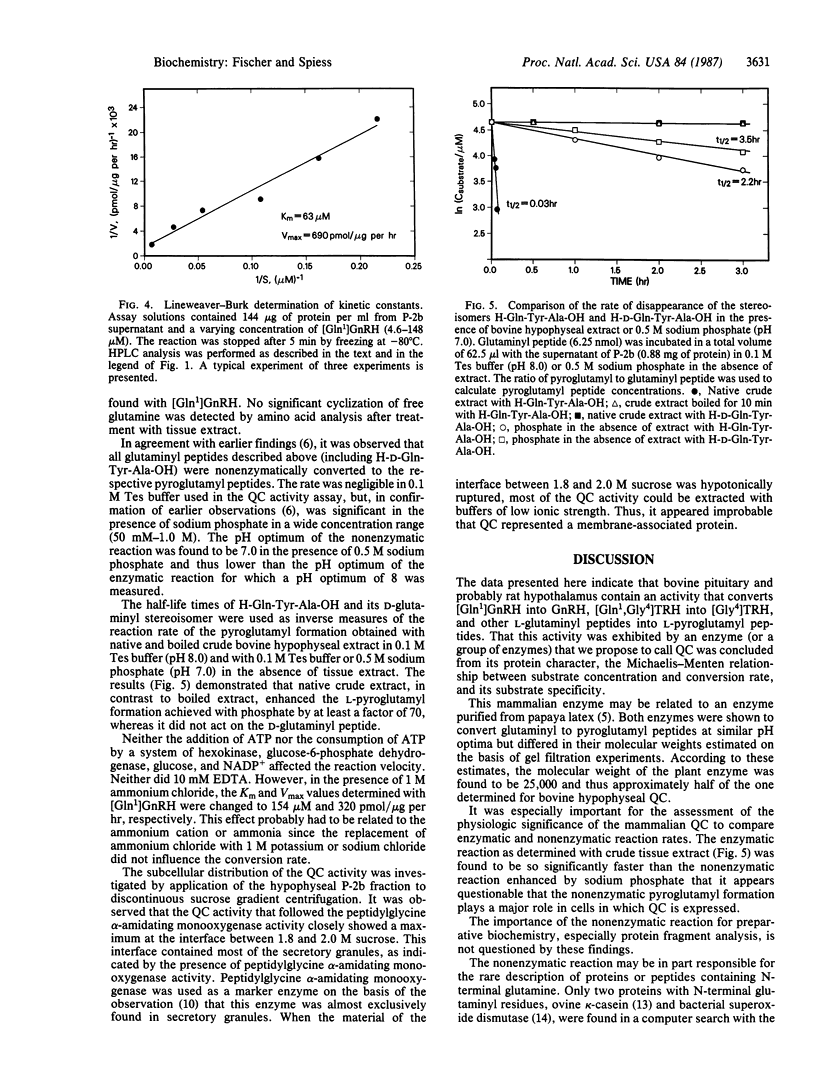Abstract
Extracts from bovine pituitary were found to contain an activity catalyzing the conversion of glutaminyl peptides such as [Gln1]gonadotropin-releasing hormone, [Gln1, Gly4]thyrotropin-releasing hormone (H-Gln-His-Pro-Gly-OH), and H-Gln-Tyr-Ala-OH to the respective pyroglutamyl peptides. The TRH precursor fragment H-Lys-Arg-Gln-His-Pro-Gly-Lys-Arg-OH and the D-glutaminyl stereoisomer of H-Gln-Tyr-Ala-OH did not react under the same conditions. The conversion products were identified by Edman degradation, amino acid analysis, and reversed-phase HPLC. That this activity was exhibited by an enzyme, glutaminyl cyclase, was concluded from the protein character of the activity (revealed by its abolition with trypsin and heat), the Michaelis-Menten relationship between substrate concentration and conversion rate, and the substrate specificity. It was determined that glutaminyl cyclase had a molecular weight of 43,000-50,000, a pH optimum at pH 8, and Km and Vmax values in the range of 60-130 microM and 390-690 pmol/microgram per hr, respectively. Glutaminyl cyclase was not observed to require ATP and could be inhibited with 1.0 M ammonium chloride, which increased the Km and decreased the Vmax value. The subcellular distribution of glutaminyl cyclase corresponded to the one of peptidylglycine alpha-amidating monooxygenase believed to catalyze C-terminal amidations during posttranslational precursor processing. It was also observed that the formation of pyroglutamyl from glutaminyl peptides occurred nonenzymatically; however, the enzymatic reaction carried out with crude extract was found to be approximately 70 times faster than the nonenzymatic reaction enhanced by phosphate. It is speculated that glutaminyl cyclase may participate in the posttranslational processing of hormonal precursors to pyroglutamyl peptides.
Full text
PDF




Selected References
These references are in PubMed. This may not be the complete list of references from this article.
- Bradbury A. F., Finnie M. D., Smyth D. G. Mechanism of C-terminal amide formation by pituitary enzymes. Nature. 1982 Aug 12;298(5875):686–688. doi: 10.1038/298686a0. [DOI] [PubMed] [Google Scholar]
- DIXON T. F., PURDOM M. Serum 5-nucleotidase. J Clin Pathol. 1954 Nov;7(4):341–343. doi: 10.1136/jcp.7.4.341. [DOI] [PMC free article] [PubMed] [Google Scholar]
- Eipper B. A., Mains R. E., Glembotski C. C. Identification in pituitary tissue of a peptide alpha-amidation activity that acts on glycine-extended peptides and requires molecular oxygen, copper, and ascorbic acid. Proc Natl Acad Sci U S A. 1983 Aug;80(16):5144–5148. doi: 10.1073/pnas.80.16.5144. [DOI] [PMC free article] [PubMed] [Google Scholar]
- Jollès J., Schoentgen F., Hermann J., Alais C., Jollés P. The sequence of sheep kappa-casein: primary structure of para-kappa A-casein. Eur J Biochem. 1974 Jul 1;46(1):127–132. doi: 10.1111/j.1432-1033.1974.tb03604.x. [DOI] [PubMed] [Google Scholar]
- Lechan R. M., Wu P., Jackson I. M., Wolf H., Cooperman S., Mandel G., Goodman R. H. Thyrotropin-releasing hormone precursor: characterization in rat brain. Science. 1986 Jan 10;231(4734):159–161. doi: 10.1126/science.3079917. [DOI] [PubMed] [Google Scholar]
- MESSER M., OTTESEN M. ISOLATION AND PROPERTIES OF GLUTAMINE CYCLOTRANSFERASE OF DRIED PAPAYA LATEX. Biochim Biophys Acta. 1964 Nov 22;92:409–411. doi: 10.1016/0926-6569(64)90204-4. [DOI] [PubMed] [Google Scholar]
- Murthy A. S., Mains R. E., Eipper B. A. Purification and characterization of peptidylglycine alpha-amidating monooxygenase from bovine neurointermediate pituitary. J Biol Chem. 1986 Feb 5;261(4):1815–1822. [PubMed] [Google Scholar]
- Richter K., Kawashima E., Egger R., Kreil G. Biosynthesis of thyrotropin releasing hormone in the skin of Xenopus laevis: partial sequence of the precursor deduced from cloned cDNA. EMBO J. 1984 Mar;3(3):617–621. doi: 10.1002/j.1460-2075.1984.tb01857.x. [DOI] [PMC free article] [PubMed] [Google Scholar]
- Seeburg P. H., Adelman J. P. Characterization of cDNA for precursor of human luteinizing hormone releasing hormone. Nature. 1984 Oct 18;311(5987):666–668. doi: 10.1038/311666a0. [DOI] [PubMed] [Google Scholar]
- Spiess J., Villarreal J., Vale W. Isolation and sequence analysis of a somatostatin-like polypeptide from ovine hypothalamus. Biochemistry. 1981 Mar 31;20(7):1982–1988. doi: 10.1021/bi00510a038. [DOI] [PubMed] [Google Scholar]
- Steffens G. J., Bannister J. V., Bannister W. H., Flohé L., Günzler W. A., Kim S. M., Otting F. The primary structure of Cu-Zn superoxide dismutase from Photobacterium leiognathi: evidence for a separate evolution of Cu-Zn superoxide dismutase in bacteria. Hoppe Seylers Z Physiol Chem. 1983 Jun;364(6):675–690. doi: 10.1515/bchm2.1983.364.1.675. [DOI] [PubMed] [Google Scholar]
- Suchanek G., Kreil G. Translation of melittin messenger RNA in vitro yields a product terminating with glutaminylglycine rather than with glutaminamide. Proc Natl Acad Sci U S A. 1977 Mar;74(3):975–978. doi: 10.1073/pnas.74.3.975. [DOI] [PMC free article] [PubMed] [Google Scholar]
- Vale W., Spiess J., Rivier C., Rivier J. Characterization of a 41-residue ovine hypothalamic peptide that stimulates secretion of corticotropin and beta-endorphin. Science. 1981 Sep 18;213(4514):1394–1397. doi: 10.1126/science.6267699. [DOI] [PubMed] [Google Scholar]


